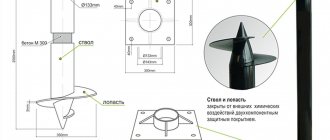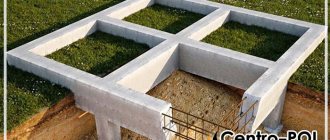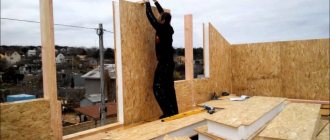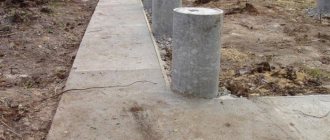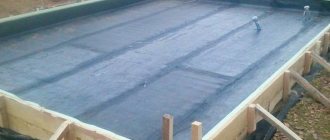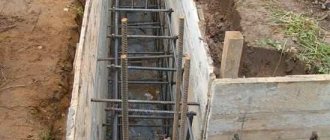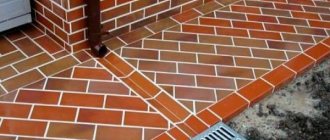The reliability and durability of the entire building depends on the quality of the foundation. Construction of a house on screw piles can be carried out on unstable soils, in a flooded area, on a site with difficult terrain, in seismically active areas.
This technology is one of the most cost-effective. It is quite easy to install screw piles with your own hands. From this article you can glean information on how to properly install screw piles so that the building will serve for many years without repair.
Content:
- Positive and negative aspects of using piles
- Types of screw supports
- Types of supports depending on the application
- Dimensions of screw piles for the base
- Number of blades
- Tip Types
- Thickness and grade of metal
- Anti-corrosion coating options
- Calculation work and plan creation
- Marking for a screw foundation
- Installing piles manually
- Use of special equipment
- Alignment of the structure
- Concrete pouring of piles from the inside
- Features of grillage installation
- Subtleties of using a monolithic grillage
- Video on screw foundation
Replacing the foundation with screw piles is appropriate in problem areas with hard or moving soil. Metal supports can provide good structural strength. To navigate the choice of piles, you need to study their varieties. You can order a turnkey screw foundation from professionals or do the installation yourself.
Approximate cost of work on installing a pile-screw foundation
The cost of work on installing a pile-screw foundation consists of such elements as the cost of the piles themselves, the cost of installation of the piles, the cost of the piping elements and their installation.
The cost of the piles themselves
It is calculated taking into account their number and size, which are either taken from the existing design documentation or from an independently performed calculation. The cost of one pile depends on the region of construction and is:
- for the minimum applicable size and diameter (length - 1.65 m, pipe diameter - 57 mm, blade diameter - 0.2 m) from 1250 rubles per piece with tip;
- for more serious piles (length - 1.65 m, pipe diameter - 108 mm, blade diameter - 0.3 m) the cost per piece with a head is already 2050 rubles.
The number of piles used for a standard foundation 6 * 6 is 9 pieces, for 9 * 9 - 16 pieces.
Cost of installation work
Calculated in case of inviting third-party specialists. It can vary greatly depending on the region of construction, time of year and workload of construction organizations. The approximate cost of installation of a pile-screw foundation is:
- about 27 thousand rubles for a building size of 6*6 and a number of piles of 9 pieces;
- about 48 thousand rubles for a building size of 9*9 and a number of piles of 16 pieces;
Positive and negative aspects of using piles
A screw foundation can be installed on any soil for one-story houses. But most often the base is installed on problematic soils. This is due to the advantages of the foundation, which have made this type of foundation popular throughout the world.
Advantages of a screw foundation:
- Strength;
- Possibility of operation in problem areas;
- Easy installation;
- The base is used in any climatic conditions;
- Construction is not affected by groundwater levels;
- Affordable price;
- Can be used on uneven ground;
- Long service life.
The disadvantages of a screw foundation are manifested in the susceptibility of the metal to corrosion, as well as in the limitations of load-bearing characteristics. In addition, the installation of piles is prohibited if there are residential buildings nearby. Metal supports can last up to 25 years. But if the soil water level is low, the foundation will last longer.
Advantages and disadvantages
The main advantage is the speed of foundation construction and accessibility (cheaper compared to strip, slab, etc.). The rods have a high load-bearing capacity, but it is not recommended to use them to build multi-story structures or heavy materials (brick).
Pros:
- minimum earthworks, simplicity of technology;
- used for the construction of structures on marshy, sloping soils;
- construction work can be continued immediately after installation of the piles;
- modernization, that is, the possibility of expanding a building under construction by adding piles;
- independence from the groundwater level;
- frost resistance;
- the underground provides high-quality ventilation. For this reason, foundations on piles are often made for wooden buildings;
- durability. High-quality rods treated against corrosion can last more than 50 years;
- possibility of manually screwing in supports;
- piles weigh less than reinforced concrete structures, so subsidence is eliminated;
- maintainability.
Minuses:
- there is no constructive opportunity to equip a basement or ground floor;
- additional costs for insulating the underground space;
- difficulty or even impossibility of construction on stony or rocky soil;
- the effect of corrosion on metal (if there are sources of stray currents nearby).
Types of supports depending on the application
The foundation for a screw structure is divided depending on the area of application. Each type has its own characteristics. Some piles can be used in private construction, while others are available only to professionals with special equipment.
Types of supports depending on the area of use:
- Piles with one wide blade at the end. They are used for the construction of outbuildings and light houses. The most popular option in construction.
- Supports with two blades. A common option for a two-story building.
- Screw piles with narrow blades. Used for rocky soils.
- A special option for areas with constant cold.
What types of piles are there?
There are several types of these products. This:
- cast products;
- welded piles.
A welded support is a pipe with a diameter of 57 to 325 mm or more. On one side there is a sharp cone and a blade. Steel tends to corrode, so the product is coated with protective compounds. The blade itself and the cone itself are produced using cutting using plasma technology. These parts are distinguished by precision manufacturing and quality of processing. There are also larger supports. They are used mainly in industrial facilities. For private construction, the popular size is 108 mm.
In turn, the classification of screw piles provides for several types of welded products:
- For laying foundations on rocky soils – provides excellent adhesion to the soil.
- In low-rise private houses of an open type, this is a basic part with round blades for ordinary types of soil.
- For small buildings with closed tip. Here the blades are larger. Designed for any soil.
Screw piles
The cast product is used in a standard size - 108 mm. This support has a significant degree of strength. The prices for such supports are much higher than for welded ones, however, these types of screw piles have many advantages. This is extraordinary strength, the supports are made of steel and are more reliable.
Cast products are also divided into types:
- for installation on thawed or waterlogged soils;
- for soils in a state of permafrost;
- for private low-rise construction.
Tip Types
The tips are welded and cast. The second option is more reliable, since it does not deform under the influence of soil. They are used for dense and hard soils, as well as in permafrost areas. Even if there is a stone on the way of the pile, the tip will not break.
Welded options are used for weak soils. Their strength can be determined by the grade and thickness of the metal. Many people are interested in how much a screw foundation using cast and welded ends costs. Prices vary. Welded structures benefit in cost; they are cheaper. But cast tips are of better quality.
Which is better: cast or welded support?
Welded bases prevent the base from tipping over or being pulled out. They are applicable for those buildings where the base experiences particularly significant horizontal loads.
Cast supports are designed for the same purposes as welded ones. However, the cast part can withstand significantly more load. They are used at the most critical facilities. This design is made with maximum precision, which increases the reliability and efficiency of the product. While the welded support is not suitable for difficult soils, the cast product is not afraid of either stones or debris. Nothing can damage the cast blade and tip.
Installation of piles
So, a comparison of screw piles shows that both types are equally good. In the case of the construction of cottage houses, both types can be used. But if you need to build something serious, engineering, then you should give preference to a cast pile. It is possible that when installing a foundation on cast supports, more force will be required, but this is not a disadvantage, but rather a plus.
Thickness and grade of metal
The thickness of steel varies. Depending on this indicator, piles are classified into three groups.
Types of supports according to metal thickness:
- Thin-walled - wall thickness does not exceed 3.5 mm;
- Piles of average thickness have an indicator of 3.5-6 mm;
- Thick-walled options exceed 6 mm.
The thickness of the piles is determined by the soil type on the site and the load on the foundation. It is necessary to decide on the indicator at the design stage. The final choice is made after examining the soil. Depending on the results obtained, the thickness of the blades is determined. If they do not exceed 5 mm, then such structures can be used for light houses. The grade of concrete is determined by the acidity of the soil.
Anti-corrosion coating options
The supports are buried in the ground and face aggressive conditions. That is why they must be protected from corrosion at the production stage. It is important not to damage the protection when installing the supports, and then repair of the screw foundation will not be required soon.
The types of anti-corrosion coating may be different. Manufacturers can use cold or hot galvanizing. Polyurethane, epoxy and polymer mixtures are used as the top layer.
Calculation work and plan creation
Piles are quite strong structures, even if they are not large. They are mounted around the perimeter of load-bearing walls, as well as in corner places. At the same time, an interval of 2-3 m is maintained between the supports. Calculation of a screw foundation involves determining the depth of the piles and the amount of materials needed for construction.
The installation depth of the piles is determined based on the level at which the ground freezes during the cold season. Installation of a screw foundation begins with preparatory work and design. You will need to clear the site and purchase all the necessary materials for construction.
Installing piles manually
You can perform the installation yourself using a special lever. You should make sure that the log goes into the ground strictly vertically. The complexity of the work depends on the diameter of the pile. If you insert a lever into the upper part, you can make the procedure easier.
The supports must be buried lower than the freezing depth of the soil. Once the pile reaches the desired point, it will be more difficult to push it further.
Concrete pouring of piles from the inside
To prevent corrosion and the formation of rye, the piles are filled with concrete from the inside. The mixture should not be too thick or thin. Concrete class – average. Metal parts must be treated with anti-corrosion compounds. Wooden parts are coated with antiseptic substances.
Features of grillage installation
When the screw foundation for the house is almost ready, you will need to install a grillage. It will serve as the foundation for the future building. For light houses, timber is used. Brick buildings must be mounted on a reinforced concrete grillage.
Immediately after installing the grillage, you can begin building the house. The fact is that the foundation does not require shrinkage.
Making and installing screw piles with your own hands
The process of manufacturing a pile-screw foundation is quite simple, so it can be done on your own without inviting professional builders. Naturally, this applies to the foundations of small buildings or structures (private house, fence, shed, etc.). When constructing a large multi-storey cottage or multi-apartment residential building, it is advisable to contact a specialized construction organization.
One of the main features of performing work using screw piles is that there is no need to prepare a pre-drilled shaft. Screw piles are mounted using the screwing method, being themselves a drill.
Thus, apart from test drilling carried out at the stage of geological testing of the soil, no additional such work is required.
The pile installation process is a sequence of the following steps:
- Calculation of parameters of a pile-screw foundation. It is carried out in the absence of ready-made design and estimate documentation made by professional designers. The calculation must be performed on the basis of geological survey data in accordance with the requirements of SNiP 2.02.03-85 in the updated version of the Code of Rules 24.13330.2011.
- Field marking. The permissible error is 1-2 cm from the dimensions provided for by the building plan.
- Installation of corner piles that serve as reference points for all other structures.
- Installation of screw piles is carried out as shown in the following video:
- Measuring horizontal heights using an optical rangefinder, followed by cutting them to a single level with a grinder.
- Pouring concrete into piles, necessary to strengthen them, displace air and additionally protect them from corrosion from the inside.
- Welding of headers with subsequent connection of all structures into a single pile-screw field. This is done using a channel (welded) or wooden logs (with self-tapping screws or studs).
- Treatment of welding seams with an anti-corrosion compound.
Subtleties of using a monolithic grillage
A do-it-yourself screw foundation with a monolithic grillage is installed on problematic soils where it is impossible to make a strip foundation. The entire load from the building falls on the grillages, which evenly distribute it on the piles.
Advantages of a monolithic grillage:
- Affordable cost of equipment;
- Construction is carried out in a short time;
- You don't need a lot of concrete to pour the piles;
- Transport and land waste is reduced;
- Does not require shrinkage;
- You can equip a screw foundation for a house yourself;
- You can do it yourself;
- The work can be done in winter.
Support sizes may vary. The popularity of monolithic structures is due to their reliability, because they are excellent for unfavorable soils.
When working with complex soils, you need to pay attention to the pros and cons of a screw foundation. This design will help level out uneven areas, heaving areas and other terrain problems. You can do the installation yourself. The main thing is to follow the technology and basic rules when working.
What are screw piles
Screw piles are made in the form of a metal pipe with a tip and screw blades at the bottom. Can be used on difficult soils. They are not suitable for installation on stony and rocky soils, as they will not be able to penetrate a very hard layer when drilling.
The lifespan of a house depends on the correct installation of piles
The dimensions of the supports depend on the mass of the raw materials from which the house will be built and the load-bearing load of building materials, people and objects in the house.
In addition, the calculation takes into account the average mass of the snow layer that may be on the roof in winter.
The service life of the entire building will depend on the correct installation of the pile-screw foundation.
Screwing screw piles is beyond the power of one person; auxiliary workers will be needed to complete the work.
